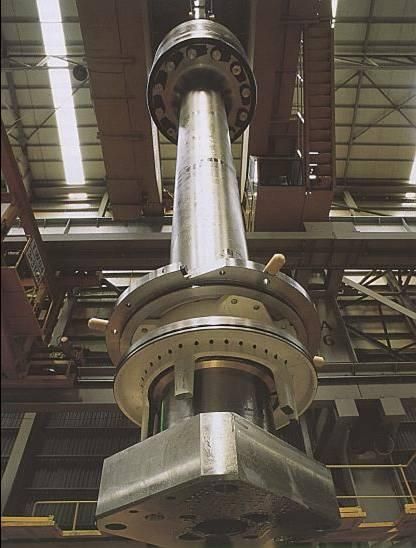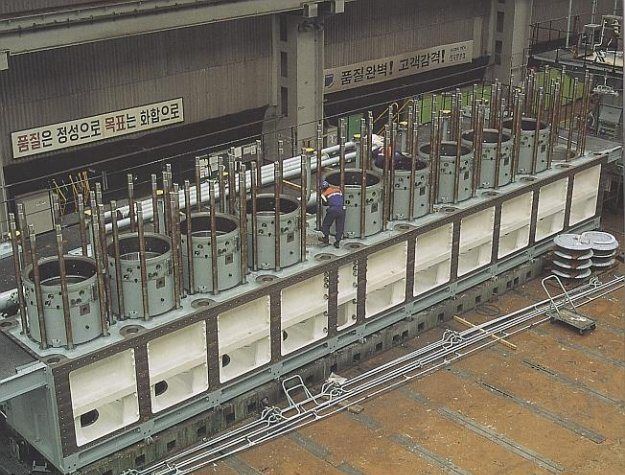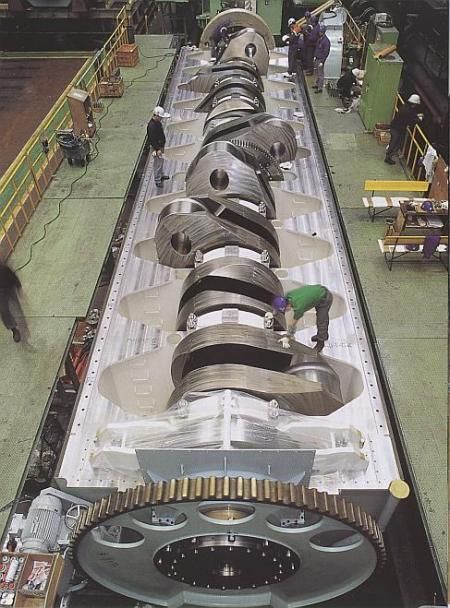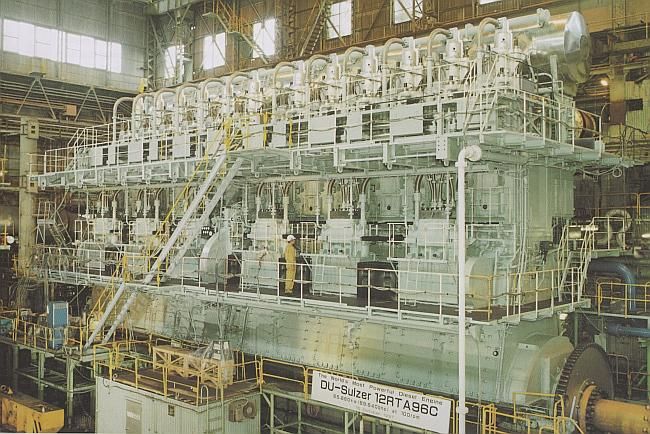[kl-bogel] The biggest diesel engine in the world - Wartsila-Sulzer-RTA96-C (6 photos)
Shipping companies worldwide are increasingly bought at shipyards supertankers and container ships. This is a booming sector of the shipbuilding market. These courts require more and more perfect filling, including marine engines. And it is for such ships by building a diesel engine factory in Finland are building the world's largest single marine engine capacity of 100 thousand kilowatts.

The company Wartsila - a world leader in marine diesel engines of high unit capacity. Since 1990
She developed a line of marine engines Wartsila - Sulzer - RTA96-C. This is a two-stroke marine diesel engines. Line -
This is because owner can order a ship's engine performance from 6 to 14 cylinders.
Structurally, these marine diesel engines are very similar.
The diameter of the cylinder marine engine of 960 mm, stroke - 2.5 meters! Cylinder diesel engine is
1820 liters. On the other characteristics - a little later. While we say that the order of hundreds of marine diesel engines in the 8, 9,
10, 11 and 12-cylinder version has been installed on vessels - container ships.
A ship with capacity of 8 - 10 thousand tons, driven by the only such ship diesel generator, quiet develop
25 knots (more than 46 kilometers per hour).
The first marine engine series Wartsila - Sulzer - RTA96-C (11-cylinder diesel) appeared in 1997. Its
produced - the Japanese company Diesel United. And in 2002, the Finnish designer announced the availability of
14-cylinder marine diesel Wartsila - Sulzer.
Now on her record in detail. Wartsila (Wärtsilä) - Sulzer (Sulzer) - RTA96-C up to 108 000 920
horsepower. The working volume of the ship's diesel generator is 25 000 480 liters. Liter capacity
Diesel extremely low - approximately 4.3 "horse" per liter.
Say, that's really strange, because in the modern automotive turbo diesel engines, engineers have learned to "withdraw" from
liters over 100 horsepower. However, the relatively low-power in such a - a gigantic scale was not chosen
casual. Large marine engines Wartsila - Sulzer (Sulzer) work with dignity, slowly (by the standards of conventional
ICE) typing in their giant "light" air.
Shaft speed at maximum power in this marine diesel is only 102 rpm
(Vs. 3-5 thousand rpm with passenger diesels). This provides a good exchange of gases in a diesel engine (imagine what
volumes of air needed to pump), a relatively low velocity of the piston in the engine, and all together - a good efficiency.
In the lowest specific fuel consumption (at full power) it exceeds 50% (probably a record for
serial ICE). Even under full load efficiency of the engine is not much lower. Specific fuel consumption is at all
modes is around 118-126 grams per horsepower per hour, which are 1.5-2.5 times lower than auto
diesels.
Comparing the figures, note that these marine diesel engines operating on heavy marine diesel oil with a much lower
energy content than the automotive counterparts.
14-cylinder Wartsila - Sulzer (Sulzer) 14RTA96-C (this is the full name of the ship's diesel engine) weighs 2,300 tons in
dry (without oil and other fluids). Weight crankshaft was 300 tons. Length of ship
diesel reaches - 26.7 meters, and height - 13.2 meters.
Of the engineering features should be noted that in each cylinder marine diesel is designed only,
Located in the center of the combustion chamber, a giant valve. There are three small valve (similar to jets in
Conventional motors) for direct injection diesel fuel into the cylinder marine engine.
This huge valve - exhaust. From him the exhaust gases go into the general collector and further to the four
turbochargers. Those, in turn, drive the fresh air through the coolers and the windows cut into the bottom of the
cylinder. Last open when the piston is lowered to the bottom of the diesel engine off the ground.
Like many marine diesel engines, the force of the piston to the crankshaft is transmitted here crosshead mechanism. It
increases the longevity of marine diesel. And the company is proud of its low weight of marine diesel engines.
Think about the loads on the parts of diesel, stringent requirements for vibration, as well as the necessary durability of the
engine (think of this change in marine diesel giant container ship).
The main material for construction of the marine diesel are traditional cast iron and steel.
So the work and talent of the creators of marine diesel engines Wartsila (Wärtsilä) deserves the deepest respect.
Meanwhile, the team of designers Wartsila (Wärtsilä) is working on a ship and more powerful engines. Already there
reference for the development of the 18-cylinder version of its heavy-duty marine diesel.
So. Facts about the 14 cylinder version:
Weight: 2,300 tons (at the crankshaft only 300 tons)
Length: 27 m
Height: 13.4 m
Maximum power: 108 920 hp at 102 rev / min
Maximum torque: 7,907,720 lb at 102 rev / min
Fuel consumption: more than 6283 liters of heavy fuel per hour





via Source
-- 
The company Wartsila - a world leader in marine diesel engines of high unit capacity. Since 1990
She developed a line of marine engines Wartsila - Sulzer - RTA96-C. This is a two-stroke marine diesel engines. Line -
This is because owner can order a ship's engine performance from 6 to 14 cylinders.
Structurally, these marine diesel engines are very similar.
The diameter of the cylinder marine engine of 960 mm, stroke - 2.5 meters! Cylinder diesel engine is
1820 liters. On the other characteristics - a little later. While we say that the order of hundreds of marine diesel engines in the 8, 9,
10, 11 and 12-cylinder version has been installed on vessels - container ships.
A ship with capacity of 8 - 10 thousand tons, driven by the only such ship diesel generator, quiet develop
25 knots (more than 46 kilometers per hour).
The first marine engine series Wartsila - Sulzer - RTA96-C (11-cylinder diesel) appeared in 1997. Its
produced - the Japanese company Diesel United. And in 2002, the Finnish designer announced the availability of
14-cylinder marine diesel Wartsila - Sulzer.
Now on her record in detail. Wartsila (Wärtsilä) - Sulzer (Sulzer) - RTA96-C up to 108 000 920
horsepower. The working volume of the ship's diesel generator is 25 000 480 liters. Liter capacity
Diesel extremely low - approximately 4.3 "horse" per liter.
Say, that's really strange, because in the modern automotive turbo diesel engines, engineers have learned to "withdraw" from
liters over 100 horsepower. However, the relatively low-power in such a - a gigantic scale was not chosen
casual. Large marine engines Wartsila - Sulzer (Sulzer) work with dignity, slowly (by the standards of conventional
ICE) typing in their giant "light" air.
Shaft speed at maximum power in this marine diesel is only 102 rpm
(Vs. 3-5 thousand rpm with passenger diesels). This provides a good exchange of gases in a diesel engine (imagine what
volumes of air needed to pump), a relatively low velocity of the piston in the engine, and all together - a good efficiency.
In the lowest specific fuel consumption (at full power) it exceeds 50% (probably a record for
serial ICE). Even under full load efficiency of the engine is not much lower. Specific fuel consumption is at all
modes is around 118-126 grams per horsepower per hour, which are 1.5-2.5 times lower than auto
diesels.
Comparing the figures, note that these marine diesel engines operating on heavy marine diesel oil with a much lower
energy content than the automotive counterparts.
14-cylinder Wartsila - Sulzer (Sulzer) 14RTA96-C (this is the full name of the ship's diesel engine) weighs 2,300 tons in
dry (without oil and other fluids). Weight crankshaft was 300 tons. Length of ship
diesel reaches - 26.7 meters, and height - 13.2 meters.
Of the engineering features should be noted that in each cylinder marine diesel is designed only,
Located in the center of the combustion chamber, a giant valve. There are three small valve (similar to jets in
Conventional motors) for direct injection diesel fuel into the cylinder marine engine.
This huge valve - exhaust. From him the exhaust gases go into the general collector and further to the four
turbochargers. Those, in turn, drive the fresh air through the coolers and the windows cut into the bottom of the
cylinder. Last open when the piston is lowered to the bottom of the diesel engine off the ground.
Like many marine diesel engines, the force of the piston to the crankshaft is transmitted here crosshead mechanism. It
increases the longevity of marine diesel. And the company is proud of its low weight of marine diesel engines.
Think about the loads on the parts of diesel, stringent requirements for vibration, as well as the necessary durability of the
engine (think of this change in marine diesel giant container ship).
The main material for construction of the marine diesel are traditional cast iron and steel.
So the work and talent of the creators of marine diesel engines Wartsila (Wärtsilä) deserves the deepest respect.
Meanwhile, the team of designers Wartsila (Wärtsilä) is working on a ship and more powerful engines. Already there
reference for the development of the 18-cylinder version of its heavy-duty marine diesel.
So. Facts about the 14 cylinder version:
Weight: 2,300 tons (at the crankshaft only 300 tons)
Length: 27 m
Height: 13.4 m
Maximum power: 108 920 hp at 102 rev / min
Maximum torque: 7,907,720 lb at 102 rev / min
Fuel consumption: more than 6283 liters of heavy fuel per hour





via Source
You received this message because you are subscribed to the Google Groups "kl-bogel" group.
To post to this group, send email to kl-bogel@googlegroups.com
To subscribe or unsubscribe at http://groups.google.com.my/group/kl-bogel/subscribe
For more options, visit this group at http://groups.google.com/group/kl-bogel?hl=en
Sebarang email pertanyaan, hantar kepada abangmod@gmail.com
Comments
Post a Comment